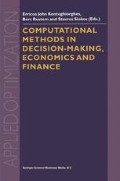Abstract
Pricing-to-market (PTM) theory stipulates that exporting monopolistic firms set different prices for their goods depending on the destination markets. In other words, firms adjust their destination-specific markup in order to conform to differing demand characteristics in each country and to account for bilateral exchange rate fluctuations that could potentially affect the demand for their goods.
Empirical support for PTM comes mostly from ordinary least squares and instrumental variable (IV) estimations of partial equilibrium models. Unfortunately, this evidence may be spurious. Indeed, it was recently shown that standard inference methods in instrumental regressions (including exogeneity tests and Wald tests on regression coefficients) are highly unreliable, particularly when the instruments at hand are uninformative.
This study revisits the PTM evidence on various Japanese manufacturing product groups and industries, taking the above concerns explicitly into account. Exogeneity tests, as well as bounds and bootstrap-type likelihood ratio tests, are therefore carried out, based on OLS and limited-information maximum likelihood estimates of the well-known PTM model developed by Marston (1990). Unlike the standard IV-based procedures, these tests are known to achieve level control even when instruments are weak.
Results reveal significant right-hand-side endogeneity in the examined PTM equations. Furthermore, whereas statistical tests which ignore this problem (i.e. which replicate Marston’s testing strategy) overwhelmingly reject the no PTM null, the tests which properly correct for endogeneity fail to reject this null for several industries. This suggests that available partial-equilibrium-based evidence in favor of PTM may not be as statistically conclusive as was previously believed.
The first author thanks the Fonds F.C.A.R. of the government of Québec for financial support. Both authors thank Richard Marston and Thomas Klitgaard for kindly providing the data sets used in this paper. We also thank Christopher Nicol and two anonymous referees for helpful comments. The views in this paper are our own and should not be attributed to the Bank of Canada.
Access this chapter
Tax calculation will be finalised at checkout
Purchases are for personal use only
Preview
Unable to display preview. Download preview PDF.
References
Bergin, P., and R.C. Feenstra. (1999). “Pricing-to-Market, Staggered Contracts and Real Exchange Rate Persistence”, NBER Working Paper 7026.
Betts, C. and M. Devereux. (1996). “The Exchange Rate in a Model of Pricing-to-Market”, European Economic Review, 40: 1007–21.
Betts, C. and M. Devereux. (1998). “Exchange Rate Dynamics in a Model of Pricing-to-Market”, discussion paper, University of British Columbia.
Betts, C. and M. Devereux. (2000). “The International Effects of Monetary and Fiscal Policy in a Two-Country Model”, Calvo, G.A., Dornbusch, R., Obstfeld, M., editors, Money, Capital Mobility and Trade: Essays in Honor of Robert A. Mundell. MIT Press, Cambridge, MA.
Campa, J. M. and L. Goldberg. (1999). “Investment, Pass-Through, and Exchange Rates: A Cross-Country Comparison”, International Economic Review, 40: 287–314.
Cheung, Y. W. and M. Chinn. (1999). “Market Structure and the Persistence of Sectoral Real Exchange Rates”, NBER Working Paper No. 7408.
Dufour, J.M. (1987). “Linear Wald Methods for Inference on Covariance Matrices and Weak Exogeneity Tests in Structural Equations”, Time Series and Econometric Modelling, I.B. MacNeil and G.J. Umphrey, editors, D. Reidel Publishing Company, 317–338.
Dufour, J.M. (1995). “Monte Carlo Tests in the Presence of Nuisance Parameters, with Econometric Applications”, working paper, C.R.D.E., Université de Montréal.
Dufour, J.M. (1997). “Some Impossibility Theorems in Econometrics with Applications to Structural and Dynamic Models”, Econometrica 65: 1365–88.
Dufour J.-M. and L. Khalaf. (1998). “Simulation Based Finite and Large Sample Inference Methods in Simultaneous Equations”, discussion paper, C.R.D.E., Université de Montréal and GREEN, Université Laval.
Dufour J.-M. and L. Khalaf. (2001). “Monte Carlo Tests Methods in Econometrics”, Baltagi B., editor, Companion to Theoretical Econometrics, Blackwell, Oxford, UK.
Faruqee, H. (1995). “Pricing-to-Market and the Real Exchange Rate”, IMF Staff Papers 42: 855–881.
Feenstra, R.C. (1989). “Symmetric Pass-Through of Tariffs and Exchange Rates Under Imperfect Competition: An Empirical Test”, Journal of International Economics 27: 25–45.
Feenstra, R.C., Gagnon, J. and M. Knetter. (1996). “Market Share and Exchange Rate Pass-Through in World Automobile Trade”, Journal of International Economics 40: 187–207.
Feenstra, R.C. and J.D. Kendall. (1997). “Pass-through of exchange rates and purchasing power parity”, Journal of International Economics 43: 237–61.
Gagnon, J. and M. Knetter. (1995). “Mark-up Adjustment and Exchange Rate Fluctuations: Evidence from Panel Data on automobile Exports”, Journal of International Money and Finance 14: 289–310.
Giovannini, A. (1988). “Exchange Rates and Traded Goods Prices”, Journal of International Economics 24: 45–68.
Goldberg, P.K. and M. Knetter. (1997). “Goods Prices and Exchange Rates: What Have We Learned?”, Journal of Economic Literature 35: 1243–1272.
Kasa, K. (1992). “Adjustment Costs and Pricing-to-Market”, Journal of International Economics 30: 1–30.
Khalaf, L. and M. Kichian. (2000). “Testing the Pricing-to-Market Hypothesis; Case of the Transportation Industry”, Bank of Canada working paper 2000–8.
Klitgaard, T. (1999). “Exchange Rates and Profit Margins: The Case of Japanese Exporters”, FRBNY Economic Policy Review, 41–54.
Knetter, M. (1993). “International Comparisons of Pricing-to-Market Behavior”, American Economic Review 83: 473–486.
Krugman, P. (1987). “Pricing-to-Market When the Exchange Rate Changes”, Real financial Linkages Among Open Economies, Arndt, S.W. and Richardson, J.D., editors, MIT Press, Cambridge, MA.
Marston, R. (1990). “Pricing To Market in Japanese Manufacturing”, Journal of International Economics 29: 217–237.
Obstfeld, M. and K. Rogoff, (1995). “Exchange Rate Dynamics Redux”, Journal of Political Economy 103: 624–60.
Obstfeld, M. and K. Rogoff, (1999). “New Directions for Stochastic Open Economy Models”, NBER Working Paper no. 7313.
Staiger, D. and J. H. Stock, (1997), “Instrumental Variables Regression with Weak Instruments”, Econometrica 65: 557–586.
Wang, J. and E. Zivot, (1998), “Inference on Structural Parameters in Instrumental Variables Regression with Weak Instruments”, Econometrica 66: 1389–1404.
Author information
Authors and Affiliations
Editor information
Editors and Affiliations
Rights and permissions
Copyright information
© 2002 Springer Science+Business Media Dordrecht
About this chapter
Cite this chapter
Khalaf, L., Kichian, M. (2002). Simulation-Based Tests of PTM. In: Kontoghiorghes, E.J., Rustem, B., Siokos, S. (eds) Computational Methods in Decision-Making, Economics and Finance. Applied Optimization, vol 74. Springer, Boston, MA. https://doi.org/10.1007/978-1-4757-3613-7_29
Download citation
DOI: https://doi.org/10.1007/978-1-4757-3613-7_29
Publisher Name: Springer, Boston, MA
Print ISBN: 978-1-4419-5230-1
Online ISBN: 978-1-4757-3613-7
eBook Packages: Springer Book Archive

